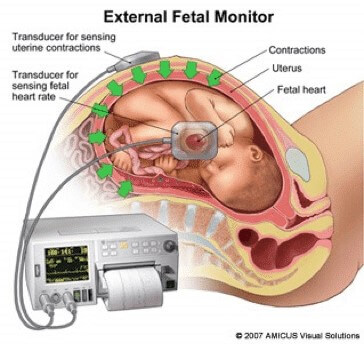A nurse is caring for a client who is in labor and has a prolapsed umbilical cord.
Which of the following actions should the nurse take first?
Apply warm saline-soaked gauze to the exposed cord
Place the client in Trendelenburg position
Administer oxygen via face mask at 10 L/min
Call for assistance and prepare for an emergency cesarean delivery
The Correct Answer is D
The correct answer is d. Call for assistance and prepare for an emergency cesarean delivery.
Rationale for Choice d:
- Emergency cesarean delivery is the definitive treatment for a prolapsed umbilical cord. It's crucial to expedite delivery to prevent fetal hypoxia and potential death.
- Any delay in delivery can have catastrophic consequences for the fetus.
- Calling for assistance immediately activates the necessary personnel and resources for a swift cesarean delivery.
- Prompt preparation ensures the operating room, anesthesia team, and surgical team are ready to proceed without delay.
Rationale for Choice a:
- Applying warm saline-soaked gauze to the exposed cord is a temporary measure to prevent cord compression and drying.
- It does not address the underlying issue of cord compression and compromised blood flow to the fetus.
- While this action is important, it should not take precedence over calling for assistance and preparing for emergency delivery.
Rationale for Choice b:
- Placing the client in Trendelenburg position (head down, feet up) was once thought to relieve pressure on the cord.
- However, current evidence does not support this practice.
- It can potentially worsen fetal distress by increasing venous return and cardiac output, leading to increased cord compression.
- It can also make it more difficult to monitor the fetal heart rate and perform a cesarean delivery.
Rationale for Choice c:
- Administering oxygen via face mask at 10 L/min may provide some benefit to the fetus by increasing maternal oxygen saturation.
- However, it does not address the primary issue of cord compression and compromised fetal blood flow.
- It should not be prioritized over calling for assistance and preparing for emergency delivery.
Nursing Test Bank
Naxlex Comprehensive Predictor Exams
Related Questions
Correct Answer is B
Explanation
Terbutaline is a medication that can relax the uterine muscles and reduce contractions.This can help relieve pressure on the prolapsed umbilical cord and restore blood flow to the baby while preparing for an emergency cesarean delivery.
Choice A is wrong because magnesium sulfate is used to prevent seizures in women with preeclampsia or eclampsia, not to treat umbilical cord prolapse.
Choice C is wrong because oxytocin is used to induce or augment labor, not to stop it.Oxytocin can increase contractions and worsen cord compression.
Choice D is wrong because methylergonovine is used to prevent or treat postpartum hemorrhage, not to treat umbilical cord prolapse.Methylergonovine can also increase contractions and worsen cord compression.

Correct Answer is C
Explanation
The correct answer is choice C. FHR of 80/min with severe variable decelerations.This indicates that the umbilical cord is prolapsed and compressed by the baby’s body, causing a decrease in blood and oxygen supply to the baby.A normal fetal heart rate is between 120 and 160 beats per minute.Severe variable decelerations are abrupt drops in the fetal heart rate that do not correspond to contractions.
Choice A is wrong because FHR of 160/min with accelerations is a normal finding that indicates a healthy baby.Accelerations are temporary increases in the fetal heart rate that usually occur with fetal movement or contractions.
Choice B is wrong because FHR of 120/min with early decelerations is also a normal finding that indicates a well-oxygenated baby.Early decelerations are gradual decreases in the fetal heart rate that mirror contractions and are caused by head compression.
Choice D is wrong because FHR of 140/min with late decelerations is an abnormal finding that indicates uteroplacental insufficiency, not cord prolapse.Late decelerations are gradual decreases in the fetal heart rate that occur after contractions and are caused by reduced blood flow to the placenta.

Whether you are a student looking to ace your exams or a practicing nurse seeking to enhance your expertise , our nursing education contents will empower you with the confidence and competence to make a difference in the lives of patients and become a respected leader in the healthcare field.
Visit Naxlex, invest in your future and unlock endless possibilities with our unparalleled nursing education contents today
Report Wrong Answer on the Current Question
Do you disagree with the answer? If yes, what is your expected answer? Explain.
Kindly be descriptive with the issue you are facing.
